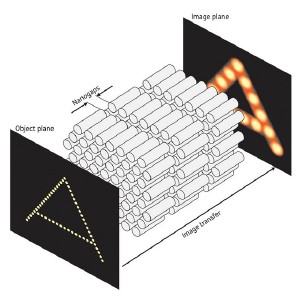Oct 10 2008
Researchers in Japan have developed a design concept for a device that allows imaging at scales previously impossible for optical instruments. Their advance is based on novel imaging techniques that allow optical imaging in the subwavelength regime, where the wavelength used is larger than the smallest features of the object being imaged. However, although subwavelength imaging is capable of significantly expanding the resolution of optical microscopes, a drawback of existing designs is that they only work at a single wavelength and in close proximity to a sample.
 A metallic nanolens. Plasmonic resonances along stacked silver nanorods are capable of long-distance image transfer and magnification.
A metallic nanolens. Plasmonic resonances along stacked silver nanorods are capable of long-distance image transfer and magnification.
The approach developed by Satoshi Kawata's team, with members from RIKEN's Advanced Science Institute, on the other hand, allows subwavelength imaging in color and at large distances from the sample. "Such nanolenses could be used to directly image viruses or the distribution of proteins in cell membranes," says Kawata, commenting on the promise of the research.
Subwavelength imaging is based on plasmonic resonances, which are collective motions of electrons at the surface of a metal that can significantly amplify light waves in the vicinity of a metal. These amplified light fields can then be used for subwavelength imaging. However, these light fields decay rapidly away from the metal, so their use in actual imaging applications is rather limited.
Reporting in Nature Photonics, the researchers present a device concept that offers a promising solution to this problem*. Similar to a relay race, light is passed along a chain of silver nanorods. A full image can be transmitted when a large number of stacked rods are bundled together.
The gaps along the stacked nanorods play an important function, despite appearing cumbersome. Firstly, the plasmonic resonances in the gaps replenish the transmitted light field that would decay rapidly along longer nanorods. Secondly, the gaps perturb the plasmonic resonances along the transmission line. As calculations by the researchers have revealed, this broadens the wavelength range that the rods can transmit, and enables the transmission of different colors along the structure. Finally, magnification of the light can be achieved if the rods are arranged such that they are tapered, which gradually expands the image as it is transmitted along the rods.
With such promising predictions, the next will be to build a device based on this concept. Whilst the researchers are continuing to improve their device design, Kawata is certain that "this invention will replace conventional lens-based optical microscopes with metallic nanolenses capable of extremely high resolution."
- Kawata, S., Ono, A. & Verma, P. Subwavelength colour imaging with a metallic nanolens. Nature Photonics 2, 438-442 (2008).